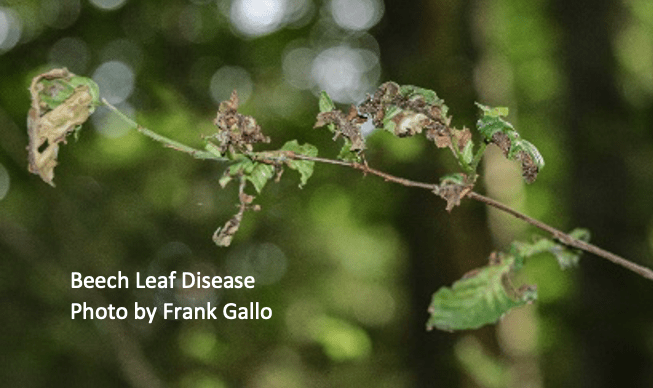
By Frank Gallo
During walks in the forest or drives through the neighborhood you may have noticed that many of the leaves of the American Beech (Fagus grandifolia) were curled and blackened and wondered why. The cause of this disfigurement, known as beech leaf disease or BLD, is a microscopic nematode worm, Litylenchus crenatae mccanai that attacks the tree’s leaves and buds. The nematode was first discovered in Ohio in 2012, and in Connecticut in 2019, and has subsequently spread quickly throughout most of New England. Although of unknown origin, evidence suggests that it is a non-native species that spreads via water films, so could potentially be dispersed by rain or through irrigation. But how they dispersed so quickly remains a mystery. Insects, birds, and wind-transported mites have all been suggested.
American beech is an integral component of eastern deciduous forests. They have been plagued by beech bark disease and canker fungi since the 1930s. This new pathogen poses another deadly threat, causing canopy defoliation and dieback which can kill a tree in two to eight years from the onset of infection. The loss of beech trees in the forest would have a devastating impact on forest ecosystems.
Beechnuts are highly nutritious, containing nearly 50% fat and 20% protein, and are a critical food source for Wild Turkeys, white-tailed deer, black bear, birds, and many other species. Bears are so beechnut dependent that researchers can predict this year’s bear population by the magnitude of last fall’s beechnut crop. American beech is host to many species of moths and butterflies including the cecropia moth (Hyalophora cercropia), and the rare, early hairstreak butterfly (Erola laeta), which feed exclusively or mainly on beech leaves. In turn, these insects provide food for hundreds of bird species.
BLD is not restricted to American Beech and is also attacking European, Oriental, Chinese, copper (F. sylvatica, F. orientalis, F. engleriana, and F. sylvatica purpurea) and other ornamental beech trees. BLD is now found throughout all eight Connecticut counties, with the severest symptoms in Fairfield, New Haven, Middlesex, and New London Counties. Given its statewide distribution, reports of BLD to the Connecticut Agricultural Experiment Station (CAES) and other state agencies are no longer requested. Examples of healthy trees, therefore, are best sought in Connecticut’s more northern counties.
Research is underway to prevent the spread of BLD and manage infected trees. There is hope that natural immunity may exist or develop in individual trees, but, for now, beech trees are under attack and a long-term solution has yet to be found. However, there are recent encouraging results from Ohio, where soil around young trees were treated biannually with potassium fertilizer. Treated trees were notably healthier than untreated ones throughout the five-year study.
In Connecticut, CAES scientists are collaborating with researchers in Ohio, New York, Pennsylvania, Ontario (Canada), and with the USDA’s- Agricultural Research Service (ARS) to study the disease and how to control it. Updates and more information on the disease and its symptoms are available through the CAES at: Beech Leaf Disease – Updates 2021 (ct.gov).
Beech Identification
American Beech are trees of moist well-drained soils and can grow (to heights of 80ft) quite large, reaching heights of 80 feet. They are easily identified by their smooth gray bark – familiar to many as the tree on which young lovers carve their names, unknowingly to the potential detriment of the tree – bright shiny green parallel-veined leaves, long brown pointy buds, and leaves that turn rust-colored in autumn and remain on the tree into winter. Their thick leaves feel a bit like plastic and bounce back into shape when squeezed and released. American beech are allelopathic, releasing chemicals into the soil that hinder the growth of competing plant species. They can also root-sprout and are frequently found in pure stands with many saplings sprouting from the roots encircling a “parent” tree.
How can you help?
1. Proper Care: Taking proper care of beech trees, including fertilizing, watering, and mulching, can enhance their resistance to disease.
2. Donations: Fund research, conservation programs, and appropriate regulations on nursery stock to prevent the introduction of new pathogens. Contributing to organizations that fund plant pathology research promotes the development of effective treatments and management approaches.
The US Department of Agriculture accepts donations for its Plant a Tree program to help replant trees in National Forests. https://plantatree.fs.usda.gov/
3. Membership: Some organizations offer membership programs, and by becoming a member, you can contribute financially and be updated on their research activities.
4. Attend Fundraising Events: Participate in fundraising events organized by these organizations. These events often include auctions, galas, or conferences where you can contribute financially while networking with researchers and fellow supporters.
5. Corporate Sponsorship: If you represent a business, consider sponsoring research initiatives, and collaborating with research institutions or universities to fund specific projects related to plant diseases.
6. Crowdfunding Campaigns: Seek out crowdfunding campaigns related to plant disease research. These campaigns are often run by researchers seeking financial support for specific projects. Platforms such as GoFundMe and Kickstarter can connect you with such initiatives.
7. Contact the Connecticut Agricultural Experiment Station (https://portal.ct.gov/caes) or UCONN Extension Services (https://cahnr.uconn.edu/extension/services/) for more information about BLD.
Frank Gallo is the Senior Naturalist at the
New Canaan Nature Center, 144 Oenoke Ridge, New Canaan, CT 06840
Web: www.newcanaannature.org.



